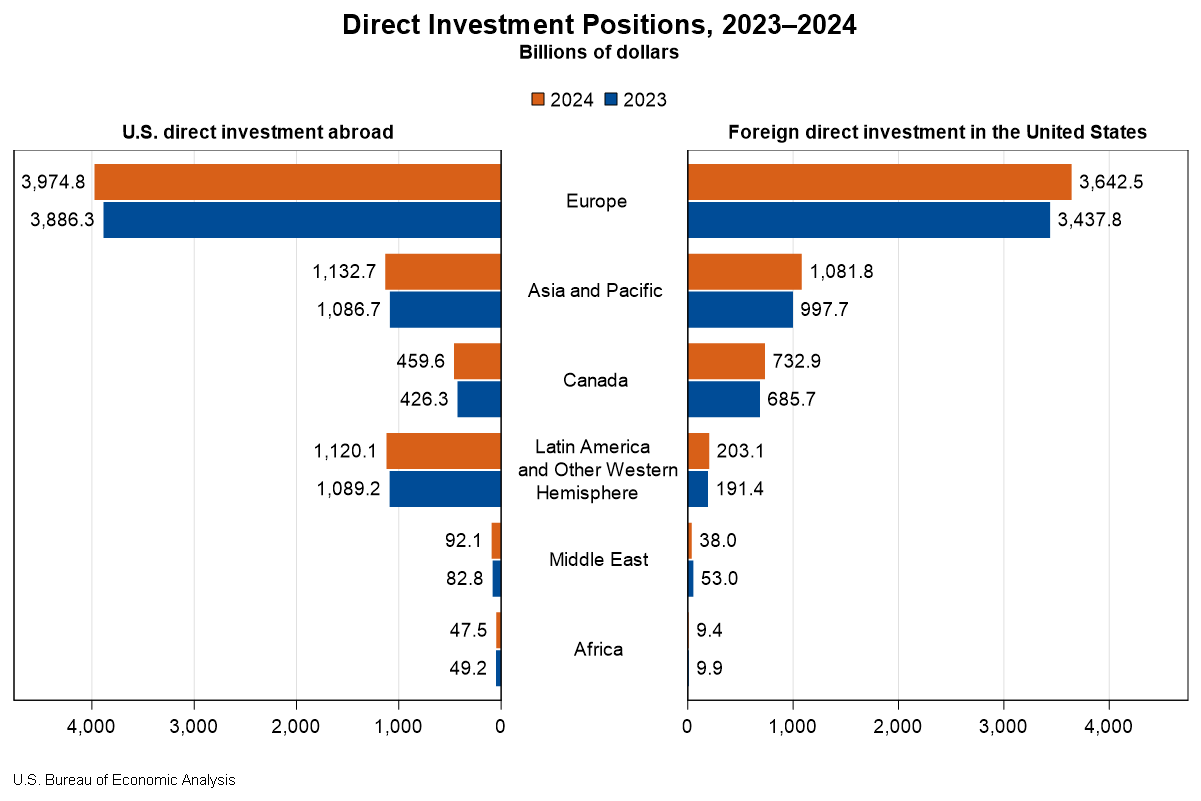Bureau of Economic Analysis
Direct Investment by Country and Industry, 2024
The U.S. direct investment abroad position, or cumulative level of investment, increased $206.3 billion to $6.83 trillion at the end of 2024, according to statistics released today by the U.S. Bureau of Economic Analysis. The increase was led by an $88.4 billion increase in the position in Europe, primarily in Luxembourg and Germany. By industry, manufacturing affiliates had the largest increase, led by manufacturing of computers and electronic products.
The foreign direct investment in the United States position increased $332.1 billion to $5.71 trillion at the end of 2024. The increase was led by a $204.7 billion increase in the position from Europe, which reflected a $52.9 billion increase from the United Kingdom and a $39.7 billion increase from Germany. By industry, affiliates in manufacturing increased the most.
Principal Federal Economic Indicators
Noteworthy
- 2025 News Release Schedule
- Innovation at BEA
- 2025 Annual Updates
- New! Services Trade Data for More Countries
- Data Tool: Trade in Value Added
- Distribution of State Personal Income
- Updated: RIMS II Regional Multipliers
- Arts and Culture
- Space Economy
- FDI Now in State BEARFACTS
- Quick Guide: Price Indexes
The Latest
U.S. International Investment Position, 2nd quarter 2017
The U.S. net international investment position increased to -$7,934.9 billion (preliminary) at the end of the second quarter of 2017 from -$8,091.6 billion (revised) at the end of the first quarter, according to statistics released today by the Bureau of Economic Analysis (BEA). The $156.7 billion increase reflected a $1,004.2 billion increase in U.S. assets and an $847.5 billion increase in U.S. liabilities (table 1).
State Personal Income, Second Quarter 2017
State personal income grew 0.7 percent on average in the second quarter of 2017, after increasing 1.4 percent in the first quarter.
State Quarterly Personal Income, 2nd quarter 2017; State Annual Personal Income, 2016
State personal income grew 0.7 percent on average in the second quarter of 2017, after increasing 1.4 percent in the first quarter. Each of the major aggregates of personal income—net earnings, property income, and personal current transfer receipts—grew more slowly than in the first quarter.
Gross Domestic Product by Metropolitan Area, 2016
Real gross domestic product (GDP) increased in 267 out of 382 metropolitan areas in 2016 according to statistics on the geographic breakout of GDP released by the Bureau of Economic Analysis. Real GDP by metropolitan area growth ranged from 8.1 percent in Lake Charles, LA and Bend-Redmond, OR to -13.3 percent in Odessa, TX (table 2).
U.S. Current-Account Deficit Increases in Second Quarter 2017
The U.S. current-account deficit increased to $123.1 billion (preliminary) in the second quarter of 2017 from $113.5 billion (revised) in the first quarter of 2017. As a percentage of U.S. GDP, the deficit increased to 2.6 percent from 2.4 percent. The previously published current-account deficit for the first quarter was $116.8 billion.
U.S. International Transactions, 2nd quarter 2017
Current-Account Balance The U.S. current-account deficit increased to $123.1 billion (preliminary) in the second quarter of 2017 from $113.5 billion (revised) in the first quarter of 2017, according to statistics released by the Bureau of Economic Analysis (BEA).
Travel and Tourism Spending Stepped up in the Second Quarter
Real spending (output) on travel and tourism accelerated in the second quarter of 2017, growing at an annual rate of 4.9 percent after increasing 4.4 percent (revised) in the first quarter, according to new statistics released by the Bureau of Economic Analysis.
Travel and Tourism Satellite Accounts, 2nd quarter 2017
Real spending (output) on travel and tourism accelerated in the second quarter of 2017, growing at an annual rate of 4.9 percent after increasing 4.4 percent (revised) in the first quarter, according to new statistics released by the Bureau of Economic Analysis. Real gross domestic product (GDP) for the nation also accelerated, increasing 3.0 percent in the second quarter (second estimate) after increasing 1.2 percent in the first quarter of…
BEA Moves Ahead on Developing Plan to Measure the Economic Impact of Outdoor Recreation
BEA is moving ahead on a project to develop a new set of statistics that measure how outdoor pursuits like fishing, camping, and hiking contribute to the economy. The Outdoor Recreation Satellite Account, or ORSA, will add up jobs, spending, and goods and services for leisure activities that range across the American landscape, from hang gliding through the sky, to diving into the sea. Release of the first experimental estimates is expected…




